Irradiation Characteristics of Non-Impregnated Micropore Graphite for Use in Molten Salt Nuclear Reactors
Abstract
1. Introduction
2. Experimental Section
2.1. Sample Preparation
2.2. Ion Irradiation
2.3. Characterization Methodology
3. Results and Discussion
3.1. Pore Structure Analysis
3.2. Morphology Variation
3.3. Structural Variation
4. Conclusions
Author Contributions
Funding
Data Availability Statement
Acknowledgments
Conflicts of Interest
References
- Serp, J.; Allibert, M.; Beneš, O.; Delpech, S.; Feynberg, O.; Ghetta, V.; Heuer, D.; Holcomb, D.; Ignatiev, V.; Kloosterman, J.L.; et al. The molten salt reactor (MSR) in generation IV: Overview and perspectives. Prog. Nucl. Energy 2014, 77, 308–319. [Google Scholar] [CrossRef]
- Abram, T.; Ion, S. Generation-IV nuclear power: A review of the state of the science. Energy Policy 2008, 36, 4323–4330. [Google Scholar] [CrossRef]
- McCoy, H.E.; Beatty, R.L.; Cook, W.H.; Gehlbach, R.E.; Kennedy, C.R.; Koger, J.W.; Litman, A.P.; Sessions, C.E.; Weir, J.R. New Developments in Materials for Molten-Salt Reactors. Nucl. Appl. Technol. 1970, 8, 156–169. [Google Scholar] [CrossRef]
- Haubenreich, P.N.; Engel, J.R. Experience with the Molten-Salt Reactor Experiment. Nucl. Appl. Technol. 1970, 8, 118–136. [Google Scholar]
- Rosenthal, M.W.; Haubenreich, P.N.; Briggs, R.B. The Development Status of Molten-Salt Breeder Reactors; Oak Ridge National Laboratory: Oak Ridge, TN, USA, 1972. [Google Scholar]
- Campbell, A.A.; Burchell, T.D. Radiation Effects in Graphite. In Comprehensive Nuclear Materials; Elsevier: Oxford, UK, 2020; pp. 398–436. [Google Scholar] [CrossRef]
- He, X.J.; Song, J.L.; Tan, J.; Zhang, B.L.; Xia, H.H.; He, Z.T.; Zhou, X.T.; Zhao, M.W.; Liu, X.D.; Xu, L.; et al. SiC coating: An alternative for the protection of nuclear graphite from liquid fluoride salt. J. Nucl. Mater. 2014, 448, 1–3. [Google Scholar] [CrossRef]
- Bernardet, V.; Gomes, S.; Delpeux, S.; Dubois, M.; Guérin, K.; Avignant, D.; Renaudin, G.; Duclaux, L. Protection of nuclear graphite toward fluoride molten salt by glassy carbon deposit. J. Nucl. Mater. 2009, 384, 292–302. [Google Scholar] [CrossRef]
- Lee, J.J.; Arregui-Mena, J.D.; Contescu, C.I.; Burchell, T.D.; Katoh, Y.; Loyalka, S.K. Protection of graphite from salt and gas permeation in molten salt reactors. J. Nucl. Mater. 2020, 534, 152119. [Google Scholar] [CrossRef]
- Kasten, P.R.; Bettis, E.S.; Cook, W.H.; Eatherly, W.P.; Holmes, D.K.; Kedl, R.J.; Kennedy, C.R.; Kirslis, S.S.; McCoy, H.E.J.; Perry, A.M.; et al. Graphite behavior and its effects on MSBR performance. Nucl. Eng. Des. 1969, 9, 157–195. [Google Scholar] [CrossRef]
- He, Z.; Lian, P.F.; Song, Y.; Liu, Z.J.; Song, J.L.; Zhang, J.P.; Feng, J.; Yan, X.; Guo, Q.G. Improving molten fluoride salt and Xe135 barrier property of nuclear graphite by phenolic resin impregnation process. J. Nucl. Mater. 2018, 499, 79–87. [Google Scholar] [CrossRef]
- Zhang, J.C.; Shi, J.L.; Zhao, Y.; Guo, Q.G.; Liu, L.; Feng, Z.H.; Fan, Z. Structural changes in four different precursors with heat treatment at high temperature and resin carbon structural model. J. Mater. Sci. 2012, 47, 5891–5899. [Google Scholar] [CrossRef]
- Zhao, H.C.; He, Z.; Liu, Z.J.; Song, J.L.; Tsang, D.K.L.; Zhang, H.Y. Self-sintered nanopore-isotropic graphite derived from green pitch coke for application in molten salt nuclear reactor. Ann. Nucl. Energy 2019, 131, 412–416. [Google Scholar] [CrossRef]
- Song, J.L.; Zhao, Y.L.; Zhang, J.P.; He, X.J.; Zhang, B.L.; Lian, P.F.; Liu, Z.J.; Zhang, D.S.; He, Z.T.; Gao, L.N.; et al. Preparation of binderless nanopore-isotropic graphite for inhibiting the liquid fluoride salt and Xe135 penetration for molten salt nuclear reactor. Carbon 2014, 79, 36–45. [Google Scholar] [CrossRef]
- Wang, T.; Li, H.; Shen, Q.; Li, K.; Li, W.; Song, Q.; Zhang, S. Dependence of mechanical properties on microstructure of high-textured pyrocarbon prepared via isothermal and thermal gradient chemical vapor infiltration. Compos. Part B Eng. 2020, 192, 107982. [Google Scholar] [CrossRef]
- Zhang, H.Y.; Cheng, J.X.; Lian, P.F.; He, Z.; Wang, Q.; Yu, A.; Song, J.L.; Tang, Z.F.; Liu, Z.J. Effects of irradiation on nano-pore phenol-formaldehyde resin infiltrated IG-110 graphite. Nucl. Mater. Energy 2022, 32, 101215. [Google Scholar] [CrossRef]
- Zhang, H.Y.; Lei, Q.T.; Song, J.L.; Liu, M.; Zhang, C.; Gao, Y.T.; Zhang, W.T.; Xia, H.H.; Liu, X.D. Direct characterization of ion implanted nanopore pyrolytic graphite coatings for molten salt nuclear reactors. RSC Adv. 2018, 8, 33927–33938. [Google Scholar] [CrossRef]
- Song, Y.Z.; Zhai, G.T.; Li, G.S.; Shi, J.L.; Guo, Q.G.; Liu, L. Carbon/graphite seal materials prepared from mesocarbon microbeads. Carbon 2004, 42, 1427–1433. [Google Scholar] [CrossRef]
- Zhou, S.; Xia, J.; Yan, L. Binderless Carbon/Graphite Materials. J. Mater. Sci. Technol. 1997, 13, 184–188. [Google Scholar]
- Zhang, H.Y.; Song, J.L.; Tang, Z.F.; Liu, Z.J.; Liu, X.D. The surface topography and microstructure change of densified nanopore nuclear graphite impregnated with polyimide and irradiated by xenon ions. Appl. Surf. Sci. 2020, 531, 147408. [Google Scholar] [CrossRef]
- Ragan, S.A.; Marsh, H. Science and technology of graphite manufacture. J. Mater. Sci. 1983, 18, 3161–3176. [Google Scholar] [CrossRef]
- Galy, N.; Toulhoat, N.; Moncoffre, N.; Pipon, Y.; Bérerd, N.; Ammar, M.R.; Simon, P.; Deldicque, D.; Sainsot, P. Ion irradiation used as surrogate of neutron irradiation in graphite: Consequences on 14C and 36Cl behavior and structural evolution. J. Nucl. Mater. 2018, 502, 20–29. [Google Scholar] [CrossRef]
- Huang, Q.; Li, J.J.; Liu, R.D.; Yan, L.; Huang, H.F. Surface morphology and microstructure evolution of IG-110 graphite after xenon ion irradiation and subsequent annealing. J. Nucl. Mater. 2017, 491, 213–220. [Google Scholar] [CrossRef]
- Zhou, X.W.; Yang, Y.; Song, J.; Lu, Z.M.; Zhang, J.; Liu, B.; Tang, Y.P. Carbon materials in a high temperature gas-cooled reactor pebble-bed module. New Carbon Mater. 2018, 33, 97–108. [Google Scholar] [CrossRef]
- Sun, X.M.; Dong, Y.J.; Zhou, Y.P.; Li, Z.C.; Shi, L.; Sun, Y.L.; Zhang, Z.Y. Effects of reaction temperature and inlet oxidizing gas flow rate on IG-110 graphite oxidation used in HTR-PM. J. Nucl. Sci. Technol. 2017, 54, 196–204. [Google Scholar] [CrossRef]
- Stoller, R.E.; Toloczko, M.B.; Was, G.S.; Certain, A.G.; Dwaraknath, S.; Garner, F.A. On the use of SRIM for computing radiation damage exposure. Nucl. Instrum. Methods Phys. Res. Sect. B-Beam Interact. Mater. Atoms 2013, 310, 75–80. [Google Scholar] [CrossRef]
- Zubair, M.; Hazem, R.; Ahmad, I.; Khan, M.I.; Zhao, T.-K.; Ali, H.; Ali, T.; Arshad, M.; Rehman, F.; Ahmad, P.; et al. The effects of 5 MeV carbon ion irradiation on micro-fine grain graphite. Radiat. Phys. Chem. 2020, 166, 108512. [Google Scholar] [CrossRef]
- Zhang, B.L.; Xia, H.H.; He, X.J.; He, Z.T.; Liu, X.D.; Zhao, M.W.; Zhou, X.T. Characterization of the effects of 3-MeV proton irradiation on fine-grained isotropic nuclear graphite. Carbon 2014, 77, 311–318. [Google Scholar] [CrossRef]
- Dickinson, J.M.; Shore, J.W. Observations concerning the determination of porosities in graphites. Carbon 1968, 6, 937–941. [Google Scholar] [CrossRef]
- Washburn, E.W. The dynamics of capillary flow. Phys. Rev. 1921, 17, 273–283. [Google Scholar] [CrossRef]
- Arregui-Mena, J.D.; Worth, R.N.; Bodel, W.; März, B.; Li, W.; Campbell, A.A.; Cakmak, E.; Gallego, N.; Contescu, C.; Edmondson, P.D. Multiscale characterization and comparison of historical and modern nuclear graphite grades. Mater. Charact. 2022, 190, 112047. [Google Scholar] [CrossRef]
- He, Z.T.; Gao, L.N.; Qi, W.; Zhang, B.L.; Wang, X.; Song, J.L.; He, X.J.; Zhang, C.; Tang, H.; Holmes, R.; et al. Molten FLiNaK salt infiltration into degassed nuclear graphite under inert gas pressure. Carbon 2015, 84, 511–518. [Google Scholar] [CrossRef]
- Zhang, H.Y.; Cheng, J.X.; Song, J.L.; Yin, H.Q.; Tang, Z.F.; Liu, Z.J.; Liu, X.D. Topography changes and microstructural evolution of nuclear graphite (IG-110) induced by Xe26+ irradiation. New Carbon Mater. 2023, 38, 393–402. [Google Scholar] [CrossRef]
- Jiang, M.; Ammigan, K.; Lolov, G.; Pellemoine, F.; Liu, D. Porosity evolution in proton irradiated microfine-grained POCO graphite. J. Nucl. Mater. 2023, 587, 154732. [Google Scholar] [CrossRef]
- Heggie, M.I.; Suarez-Martinez, I.; Davidson, C.; Haffenden, G. Buckle, ruck and tuck: A proposed new model for the response of graphite to neutron irradiation. J. Nucl. Mater. 2011, 413, 150–155. [Google Scholar] [CrossRef]
- Manoj, B. Investigation of nanocrystalline structure in selected carbonaceous materials. Int. J. Miner. Metall. Mater. 2014, 21, 940–946. [Google Scholar] [CrossRef]
- Manoj, B.; Kunjomana, A.G. Study of Stacking Structure of Amorphous Carbon by X-Ray Diffraction Technique. Int. J. Electrochem. Sci. 2012, 7, 3127–3134. [Google Scholar] [CrossRef]
- Zhou, Z.; Bouwman, W.G.; Schut, H.; van Staveren, T.O.; Heijna, M.C.R.; Pappas, C. Influence of neutron irradiation on the microstructure of nuclear graphite: An X-ray diffraction study. J. Nucl. Mater. 2017, 487, 323–330. [Google Scholar] [CrossRef]
- Asthana, A.; Matsui, Y.; Yasuda, M.; Kimoto, K.; Iwata, T.; Ohshima, K.-I. Investigations on the structural disordering of neutron-irradiated highly oriented pyrolytic graphite by X-ray diffraction and electron microscopy. J. Appl. Crystallogr. 2005, 38, 361–367. [Google Scholar] [CrossRef]
- Dai, Z.B.; Cao, X.L.; Xu, K.; Shen, K. Research progress on irradiation defects and crystal size change of graphite crystal. Carbon Tech. 2022, 41. [Google Scholar] [CrossRef]
- Cançado, L.G.; Takai, K.; Enoki, T.; Endo, M.; Kim, Y.A.; Mizusaki, H.; Speziali, N.L.; Jorio, A.; Pimenta, M.A. Measuring the degree of stacking order in graphite by Raman spectroscopy. Carbon 2008, 46, 272–275. [Google Scholar] [CrossRef]
- Mathew, S.; Chan, T.K.; Zhan, D.; Gopinadhan, K.; Barman, A.R.; Breese, M.B.H.; Dhar, S.; Shen, Z.X.; Venkatesan, T.; Thong, J.T.L. The effect of layer number and substrate on the stability of graphene under MeV proton beam irradiation. Carbon 2011, 49, 1720–1726. [Google Scholar] [CrossRef]
- Jiang, M.; Ammigan, K.; Lolov, G.; Pellemoine, F.; Liu, D. A novel method for quantifying irradiation damage in nuclear graphite using Raman spectroscopy. Carbon 2023, 213, 118181. [Google Scholar] [CrossRef]
- Tuinstra, F.; Koenig, J.L. Raman Spectrum of Graphite. J. Chem. Phys. 1970, 53, 1126–1130. [Google Scholar] [CrossRef]
- Ferrari, A.C.; Robertson, J. Origin of the 1150 cm−1 Raman mode in nanocrystalline diamond. Phys. Rev. B 2001, 63, 121405. [Google Scholar] [CrossRef]
- Ferrari, A.C.; Robertson, J. Resonant Raman spectroscopy of disordered, amorphous, and diamondlike carbon. Phys. Rev. B 2001, 64, 075414. [Google Scholar] [CrossRef]
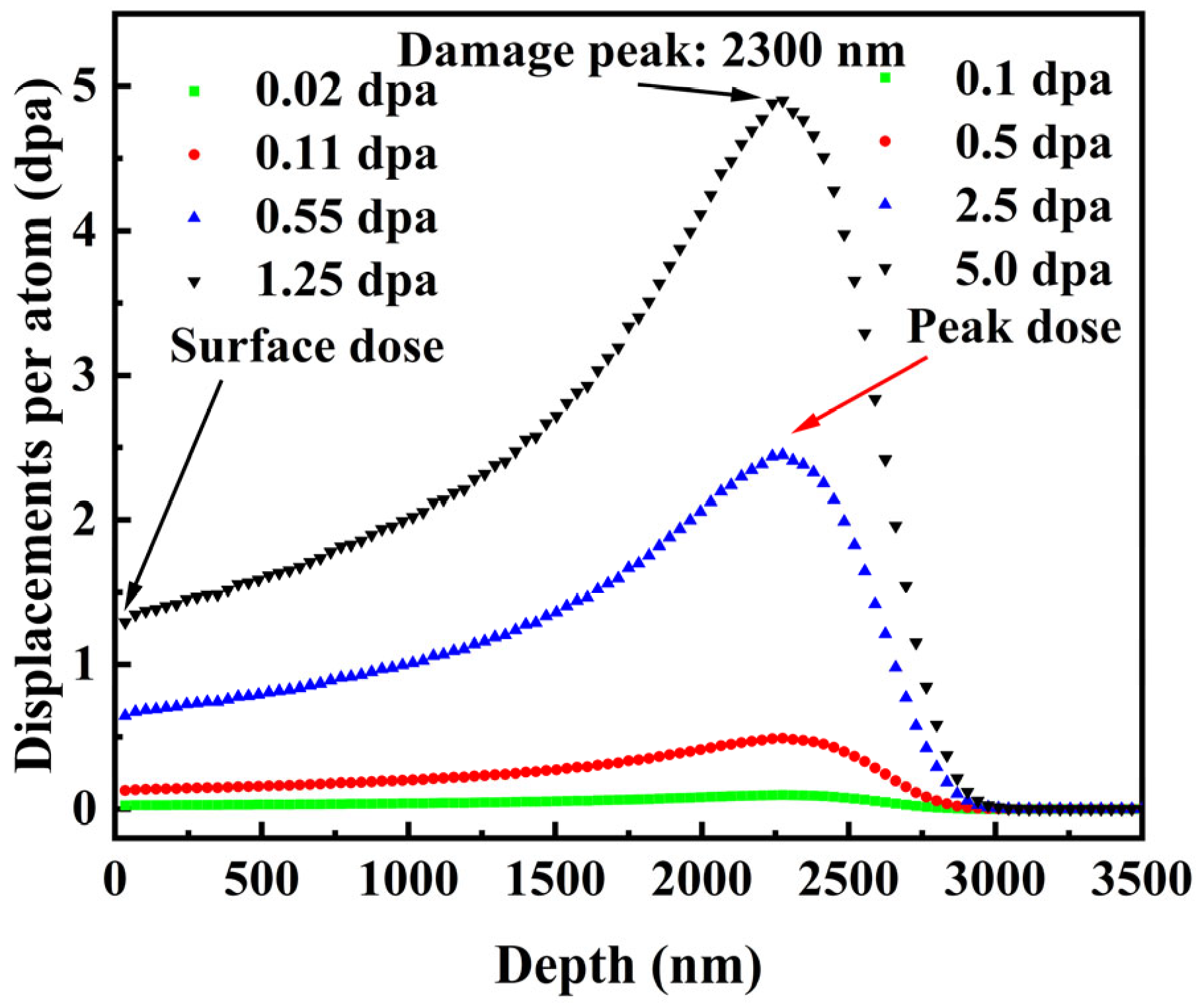
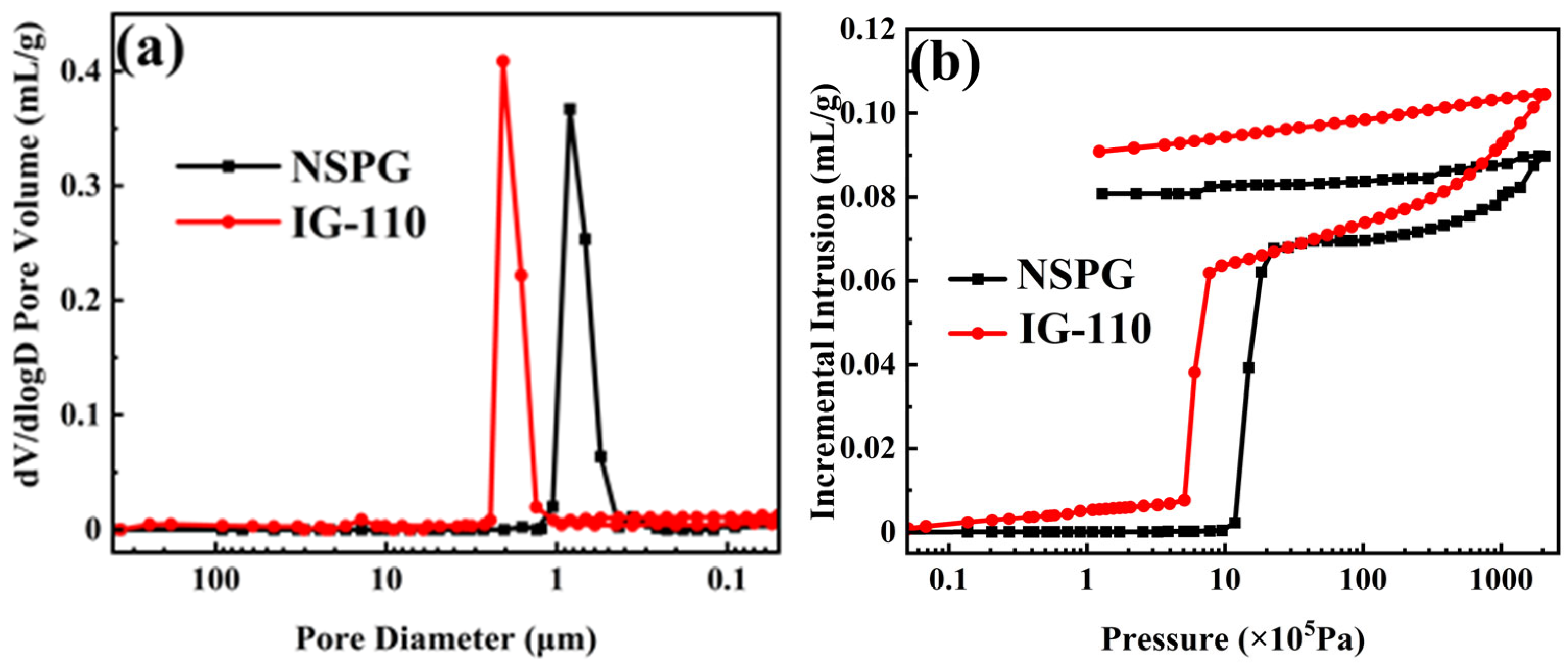
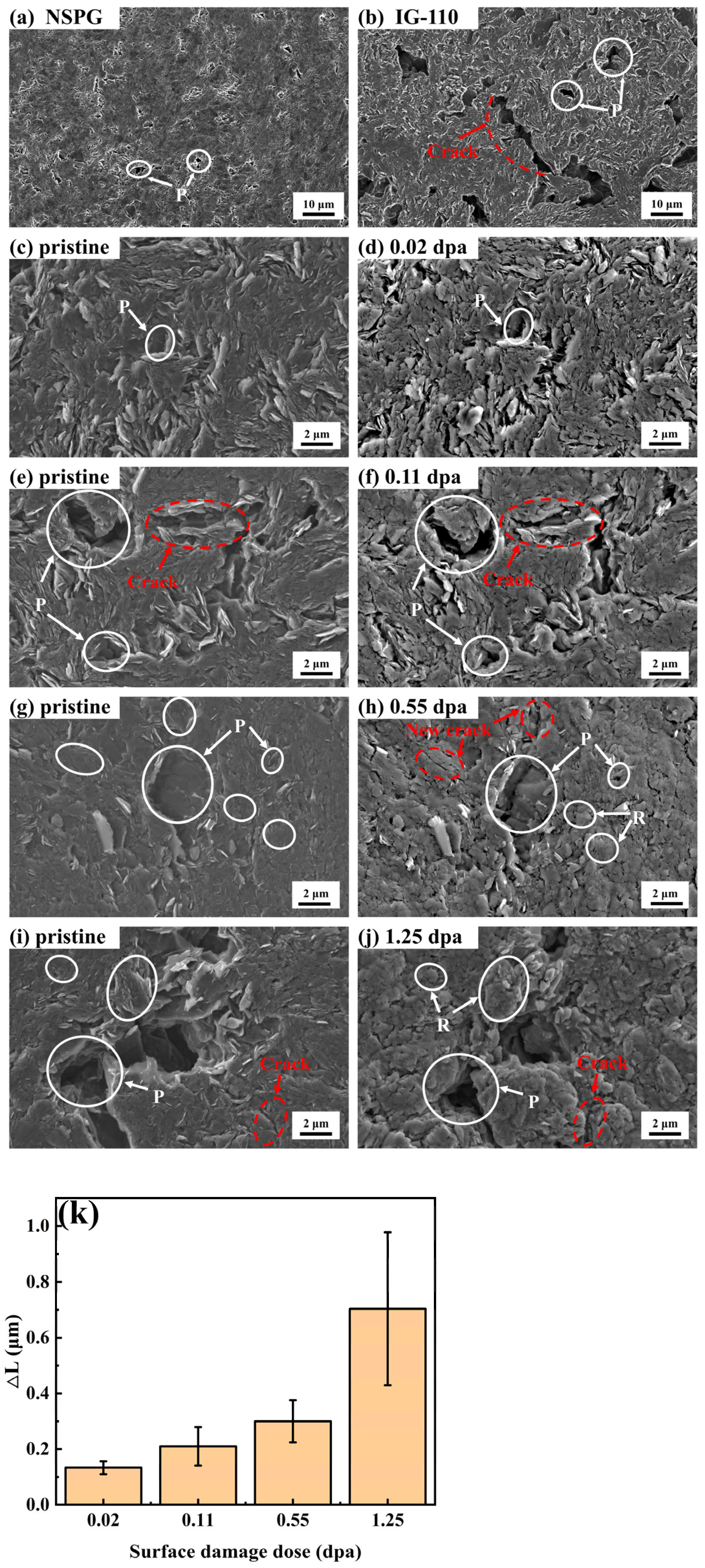
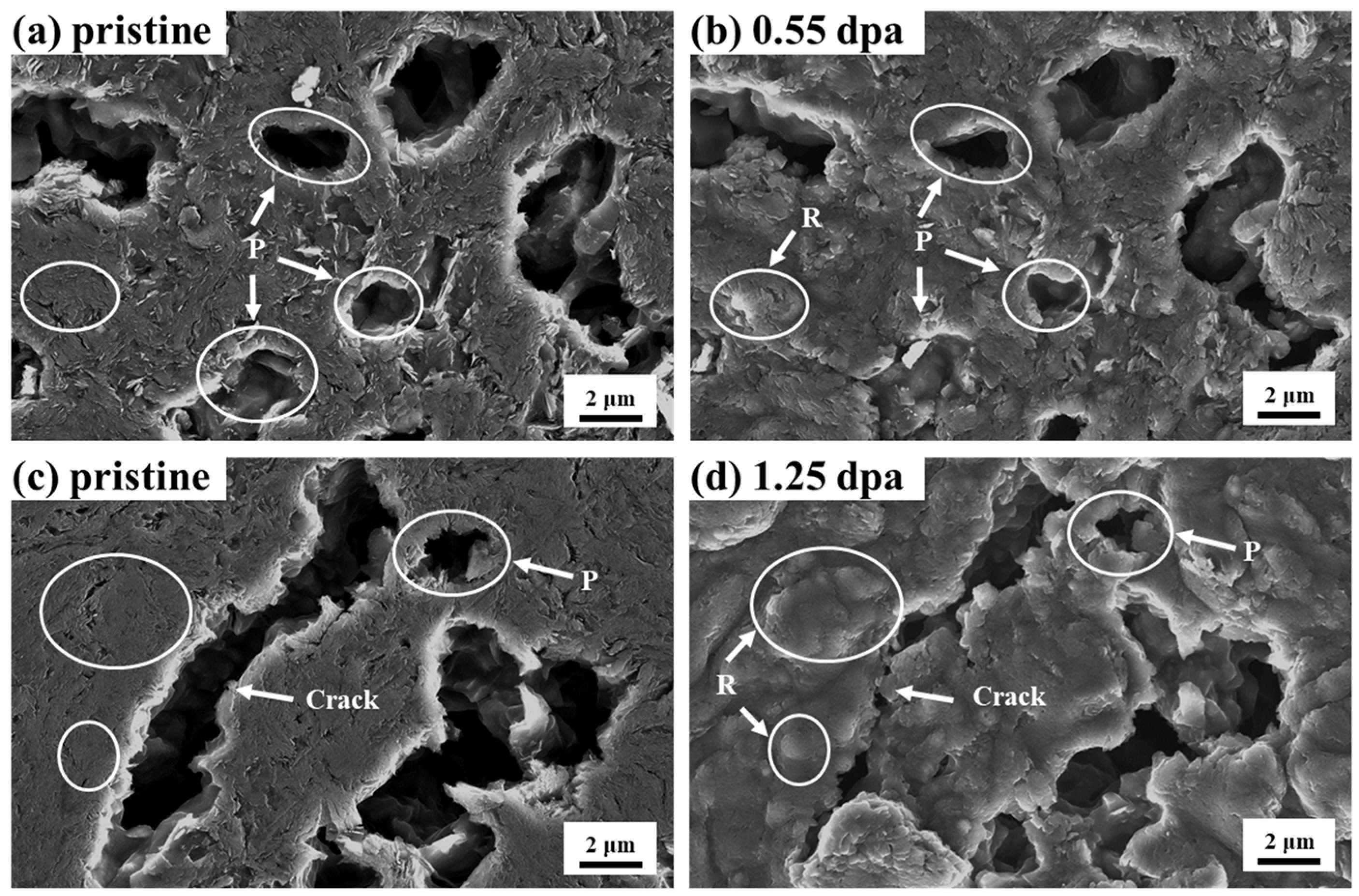
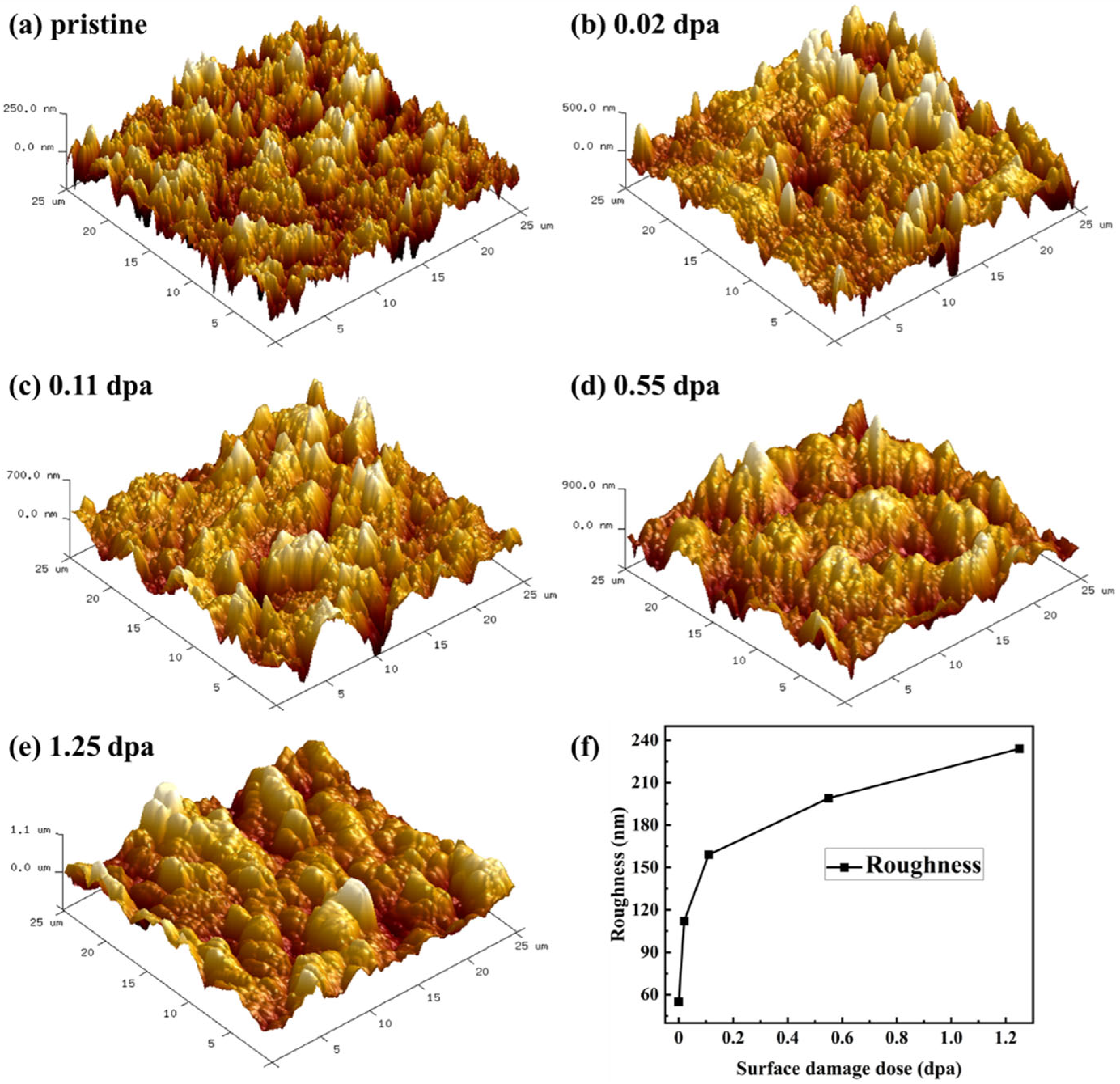
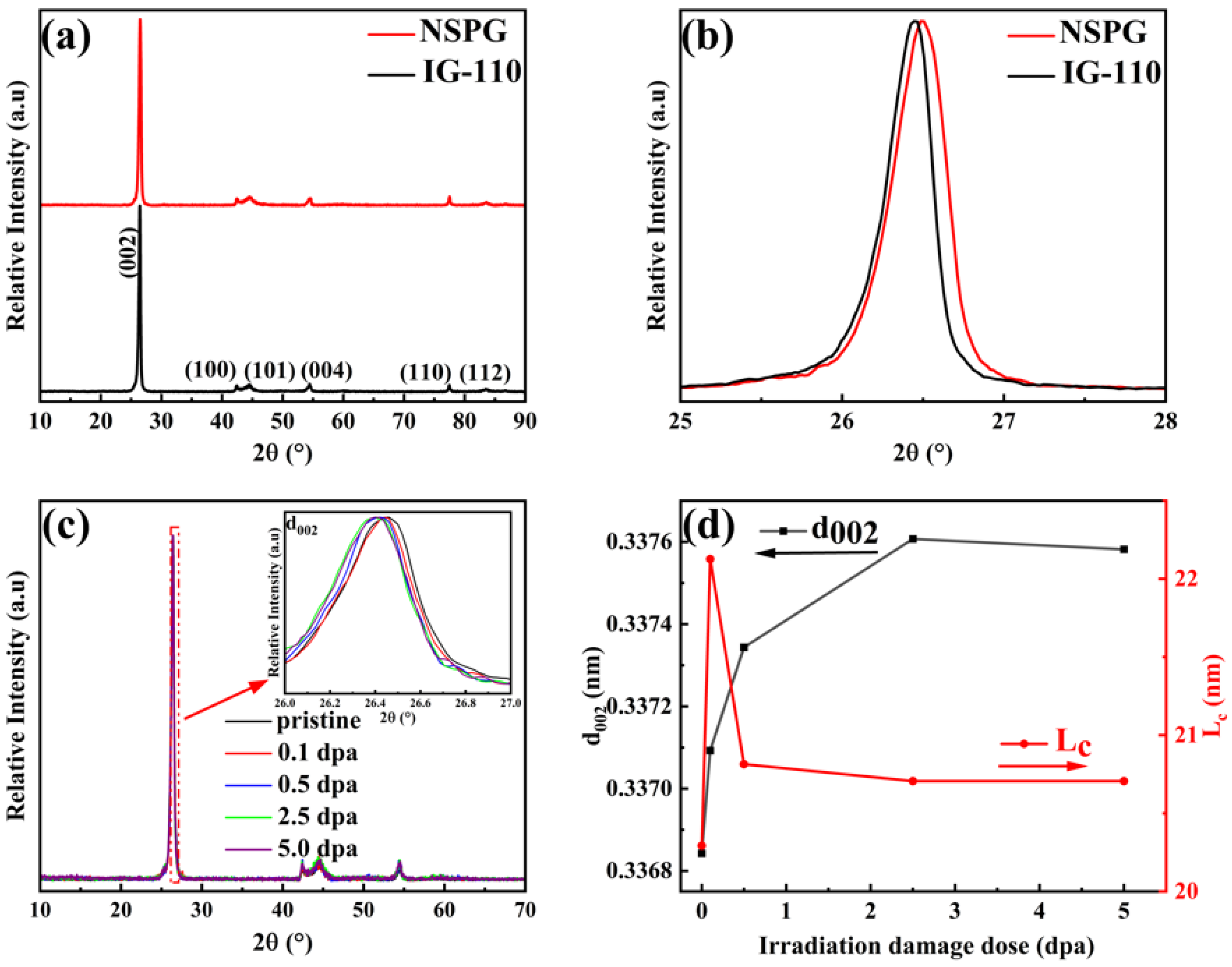

| Fluence (Ions/cm2) | Peak Irradiation Dose (dpa) | Surface Irradiation Dose (dpa) |
|---|---|---|
| 9.6 × 1013 | 0.1 | 0.02 |
| 4.8 × 1014 | 0.5 | 0.11 |
| 2.4 × 1015 | 2.5 | 0.55 |
| 4.8 × 1015 | 5.0 | 1.25 |
| Properties | IG-110 | NSPG |
|---|---|---|
| Bulk density (g/cm3) | 1.77 ± 0.02 | 1.79 ± 0.02 |
| Open porosity (%) | 18.4 ± 0.1 | 15.9 ± 0.1 |
| Median pore diameter (volume, μm) | 1.840 | 0.802 |
| Flexure strength (MPa) | 39.2 ± 2.5 | 61.0 ± 2.5 |
| Compressive strength (MPa) | 78 ± 3 | 102 ± 3 |
| Thermal conductivity (W/m·K) | 116 ± 2 | 127 ± 2 |
| CTEs (25–300 °C, 10−6/K) | 4.5 ± 0.2 | 4.1 ± 0.2 |
| Graphite | NSPG/IG-110 | ||||
|---|---|---|---|---|---|
| Irradiation damage dose (dpa) | 0 | 0.1 | 0.5 | 2.5 | 5.0 |
| Crystallite lateral size La (nm) | 31.516/24.976 | 18.664/8.339 | 11.581/7.633 | 9.423/7.542 | 9.111/7.267 |
Disclaimer/Publisher’s Note: The statements, opinions and data contained in all publications are solely those of the individual author(s) and contributor(s) and not of MDPI and/or the editor(s). MDPI and/or the editor(s) disclaim responsibility for any injury to people or property resulting from any ideas, methods, instructions or products referred to in the content. |
© 2024 by the authors. Licensee MDPI, Basel, Switzerland. This article is an open access article distributed under the terms and conditions of the Creative Commons Attribution (CC BY) license (https://creativecommons.org/licenses/by/4.0/).
Share and Cite
Lian, P.; Li, P.; Huang, H.; Song, J.; Tang, Z.; Liu, Z. Irradiation Characteristics of Non-Impregnated Micropore Graphite for Use in Molten Salt Nuclear Reactors. C 2024, 10, 50. https://doi.org/10.3390/c10020050
Lian P, Li P, Huang H, Song J, Tang Z, Liu Z. Irradiation Characteristics of Non-Impregnated Micropore Graphite for Use in Molten Salt Nuclear Reactors. C. 2024; 10(2):50. https://doi.org/10.3390/c10020050
Chicago/Turabian StyleLian, Pengfei, Pengda Li, Hefei Huang, Jinliang Song, Zhongfeng Tang, and Zhanjun Liu. 2024. "Irradiation Characteristics of Non-Impregnated Micropore Graphite for Use in Molten Salt Nuclear Reactors" C 10, no. 2: 50. https://doi.org/10.3390/c10020050
APA StyleLian, P., Li, P., Huang, H., Song, J., Tang, Z., & Liu, Z. (2024). Irradiation Characteristics of Non-Impregnated Micropore Graphite for Use in Molten Salt Nuclear Reactors. C, 10(2), 50. https://doi.org/10.3390/c10020050








